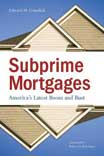For 30 years now, the American public has been bombarded with the message that government is the source of oppression and markets the fount of freedom. Government laws are coercive, while market exchanges are voluntary. In the free market you never have to do anything you don’t want to do. Therefore, the less government we have, the freer we are. Right?
Wrong. As the British political philosopher Isaiah Berlin wrote: “Freedom for the pike is death for the minnow.” In the absence of protections for the weak and the vulnerable, free markets can lead to oppression just as surely as unjust governments. And, as the mortgage crisis shows, when markets run amok, it isn’t just the weak and vulnerable who are hurt. The rash of foreclosures is slashing the value of middle-income homes, putting local governments and school districts in fiscal stress, and even threatening to pull the entire economy into a recession.
Appointed to the Board of Governors of the Federal Reserve System by President Clinton in 1997, Edward M. (Ned) Gramlich saw the train wreck coming as early as 2000 and did everything he could to warn federal regulators. As chair of the Consumer and Community Affairs Committee, Gramlich helped overcome the strong opposition of the lending industry to finally require reporting on relatively higher-cost loans in 2004. Gramlich warned Alan Greenspan, the powerful chairman of the Federal Reserve Board, in person about the impending crisis but Greenspan ignored him. In his book, The Age of Turbulence, Greenspan argued that “the benefits of broadened homeownership are worth the risk [of foreclosures].”
Before he died of acute myeloid leukemia in September 2007, Gramlich published a lucid and penetrating account of the origins of the foreclosure crisis, Subprime Mortgages: America’s Latest Boom and Bust. Unlike free-market ideologists, Gramlich looked unblinkingly at the facts, showing how deregulation created incentives to seduce homebuyers into unsustainable loans. The book summarizes a bewildering array of data in a clear, almost casual style without losing crucial complexities. For those who want to understand how we got into the mortgage mess, Gramlich’s little book is a must-read.
Gramlich tells the story of how the United States moved from a highly successful regulated mortgage market to an unregulated predatory one. The regulated market had its origins in the New Deal which, in response to the housing collapse during the Great Depression, helped to create the 30-year fixed-rate mortgage with 10 to 20 percent down, putting homeownership within reach of millions more Americans. (Before the 1930s, down payments of 30 to 50 percent were common, and loan terms were short, often six years with a balloon payment of the balance of the loan due at that time.) By standardizing mortgages, the federal government helped to create a secondary market, with investors purchasing large pools of mortgages and thus insuring liquidity in the mortgage market. In exchange for certain privileges, such as deposit insurance, savings and loans were required to invest most of their deposits in local mortgages. The FHA and VA helped to expand homeownership to moderate-income families through mortgage insurance. In a little more than a decade after the end of World War II, the homeownership rate in the United States increased from 45 to 65 percent.
A persistent problem with this regulated market is that minorities were routinely denied access to these highly desirable mortgages. Prodded by community-based organizations (CBOs), Congress passed the Home Mortgage Disclosure Act in 1975 and the Community Reinvestment Act (CRA) in 1977. Gramlich observes that the loans made to low- and moderate-income households to satisfy CRA obligations had default rates that were “pleasantly low.” Banks found that they could make a profit lending to previously excluded families, many of whom had been rejected because of their race or their neighborhood. Screened and counseled by CBOs, these households were creditworthy customers.





Comments